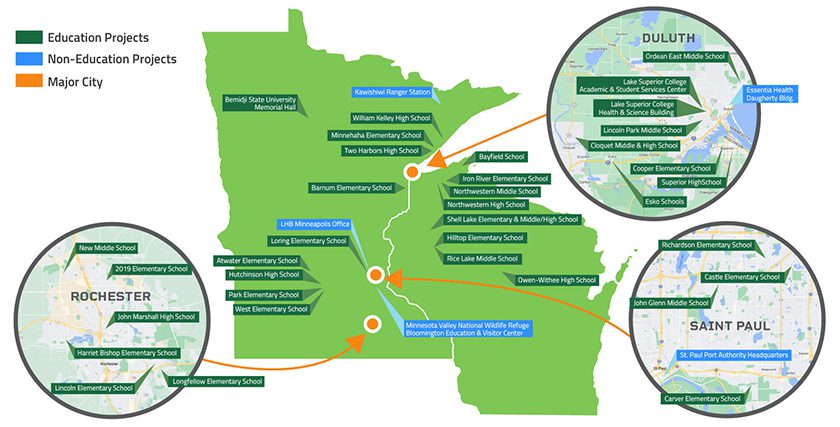

For more than two decades, LHB has been designing projects with an alternative ventilation system that provides multiple benefits: better indoor air quality, fewer sick days, less noise, a more comfortable environment, and reduced installation and operating costs.
These benefits are achieved by Thermal Displacement Ventilation (TDV), which supplies 100% fresh air free of viral and bacterial contaminants, tempered for comfort, and filtered for allergens and pollution. Air is exhausted outside the building, so there is no mixing with the supply air.
Although TDV has been used for decades in Europe, its adoption in the U.S. has lagged. LHB started designing these systems in the early 2000s to: reduce indoor CO2 levels, reduce airborne illness transmission, reduce mechanical noise, and increase energy efficiency. Nearly 20 years later, with the importance of indoor air quality magnified by a global pandemic, this ventilation strategy deserves a second, and third look.
Standard ventilation systems in buildings are designed to mix the air, within the room and some within the building. This is intended to provide thermal comfort, but a major downside is the full distribution of airborne germs and particles, in addition to creating drafts and in some cases, excessive noise levels. Generally speaking, traditional systems only provide a portion of fresh air mixed with recirculated air back into the rooms. Depending on filtration and where that mixing occurs, those systems may disperse the contaminates to all rooms in the building served by that ventilation unit.
Thermal Displacement Ventilation improves indoor air by providing fresh air in the occupied zone (below 6’ height) and no mixed air within individual rooms. Displacement ventilation is accomplished by delivering supply air through low-velocity diffusers, usually at a height below 4 feet, and at a lower temperature than the space setpoint, typically 62-68 degrees Fahrenheit. This strategy increases the separation of fresh (cooler) air from contaminated (warmer) air as the warm air naturally rises. Cool, unused air stays in the occupied zone; warm, exhaled air rises to the ceiling where it is removed from the room.
LHB’s original intent was to provide optimal air quality in schools to reduce the spread of the common flu and decrease CO2 levels in an energy-efficient and quiet manner. We began designing thermal displacement systems with outdoor air, predominantly in Pre-K-12 Education designs, without cooling or dehumidification. Using 100% fresh air eliminates the re-circulation of contaminated air within the room and the building itself. In the last eight years, LHB has improved this design strategy by adding dehumidification and cooling to increase overall building comfort. Over the past 20 years, LHB has implemented this strategy in other building types with great success, including the Ely Ranger Station, Memorial Hall at Bemidji State University, and our own office in Minneapolis.
TDV has been used successfully in conjunction with energy recovery systems to inexpensively preheat or precool the outside air. It is then filtered to remove pollens and other outdoor air particulates prior to distribution. The pretreated and filtered 100% fresh air is then heated or cooled to the final temperature and distributed directly to the occupied zone of the rooms. At no time does the exhausted air come in contact with the fresh air from the exterior, thereby eliminating any possible recirculation of airborne contaminants.

LHB has designed TDV systems for school districts including Hutchinson, Superior, Barnum, Shell Lake, and Esko. We are currently designing these systems for four Rochester Public Schools projects. What’s more, this system has proven to cost far less than traditional air conditioning systems, while being much quieter, and providing superior air quality with the removal of air contaminants.
Simply stated, the air in these buildings is better than the air outside.
There is no doubt that Covid-19 will have a lasting impact on the physical environments where we live, work, learn, and play. Official guidance to avoid indoor spaces and proximity to other people has changed the way the average person thinks about the air they breathe.
Eventually, vaccination progress will allow us to share indoor spaces once again. Through the lens of a global pandemic, the common cold, flu, or other airborne illnesses, LHB-designed Thermal Displacement Ventilation (TDV) systems offer a commonsense approach to improving indoor air quality with significant additional benefits to the building operators and occupants. ∎